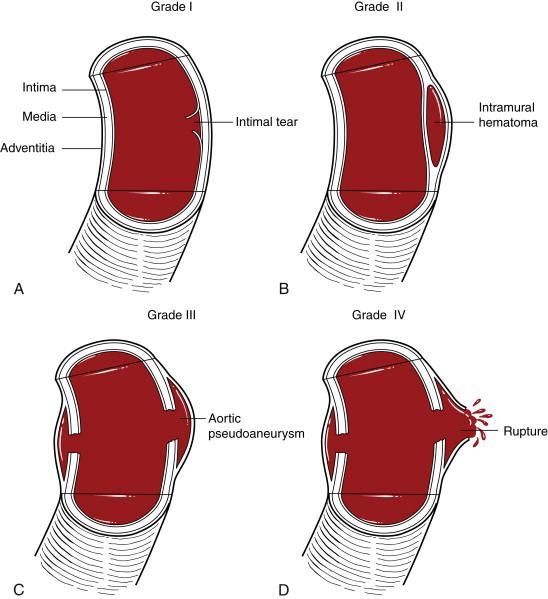Physical Address
304 North Cardinal St.
Dorchester Center, MA 02124
Traumatic aortic injury is the result of a high-velocity or deceleration injury to the wall of the aorta, which most commonly occurs at the level of the ligamentum arteriosum, proximal to the third intercostal artery. Of those patients who reach the hospital, the lesion is most often a noncircumferential injury limited to the intima and media. It may range from subintimal hemorrhage, with or without an intimal tear, to complete transection. If all three layers are involved, rapid exsanguination occurs. However, if the adventitial layer is intact, tamponade from periaortic tissue with resultant pseudoaneurysm formation allows patients to reach nearby medical facilities. Traumatic aortic injury is an unstable condition that can cause rapid patient deterioration anytime after injury.
The principle of early diagnosis and treatment was first established by Parmley and associates in 1958, who reviewed 275 cases of traumatic aortic rupture. Of the 38 (13.8%) patients who reached the hospital alive, 3 patients died within 1 hour and 23 (61%) died of rupture within 1 week of admission. Subsequent studies have demonstrated that as many as 70% of patients survive with surgical treatment. Through the advancement of minimally invasive techniques, most traumatic aortic injuries are now repaired using an endovascular approach.
Delayed repair of thoracic aortic injury may be considered in select, stable patients where the injury is more than 4 hours old, such as high-risk elderly patients with major comorbidities or those with associated head injury, pulmonary injury, and coagulopathy. An anatomic injury grading scheme (grades I-IV) has been developed to identify those patients with a grade I or II injury who may be appropriate for a more conservative approach ( Fig. 22-1 ). Unfortunately, it is not possible to differentiate those intimal injuries that display a more stable course from those that will progress to rupture. Approximately 10% of stable patients will rupture before repair. Thus patients should be considered for emergent repair in the presence of hemodynamic instability, an enlarging mediastinal hematoma, or worsening pleural effusion.

Patients with suspected thoracic aortic injury should be transferred to a level I trauma center for treatment of their associated traumatic injuries, as well as for respiratory and cardiovascular stabilization.
Computed tomography (CT) angiography has a sensitivity of nearly 100% for diagnosing traumatic aortic transection. Although the diagnosis of aortic injury can be made by transesophageal echocardiography, it is not as sensitive as CT angiography.
Signs of aortic disruption on chest radiography may include a widened mediastinum, a rightward shift of the trachea, blurring of the aortic knob, opacification of the juncture between the aorta and the pulmonary trunk, and a left-sided hemothorax ( Table 22-1 ) .
| Sign | Suspected Thoracic Aortic Injury on Chest Radiograph ∗ (%) | Angiographic Confirmation of Injury (%) |
|---|---|---|
| Mediastinum > 8 cm | 76 | 27 |
| Indistinct descending aortic arch contour | 76 | 5 |
| Indistinct aortic contour | 12 | 85 |
| Trachea displaced to the right | 61 | 78 |
| Nasogastric tube or esophagus displaced to the right | 67 | 87 |
| Left main stem bronchus displaced inferiorly | 53 | 84 |
| Pleural apical cap | 37 | 68 |
| Fracture of rib 1 or 2 | 17 | 70 |
∗ Given that chest radiographic examination may fail to identify a traumatic thoracic injury in as many as 11% of patients, CT angiography is recommended in any patient with a suspected injury. Data from Matsumura JS, Cambria RP, Dake MD, et al: International controlled clinical trial of thoracic endovascular aneurysm repair with the Zenith TX2 endovascular graft: 1-year results. J Vasc Surg 47:247, 2008.
In the presence of suspected aortic injury, strict blood pressure control is mandatory with beta-blockade and afterload reduction to reduce aortic wall stress.
If the patient is unstable, with evidence of possible aortic disruption on chest radiograph, transfer to the operating room is recommended for angiography and repair if an aortic injury is confirmed.
Three-dimensional CT imaging facilitates preoperative planning, including endograft selection and assessment of access vessel tortuosity and caliber. Because endovascular repair often requires coverage of the left subclavian artery, knowledge of the vertebral anatomy and prior history of coronary artery bypass grafting with a left internal mammary artery graft is critical. Concomitant pelvic fracture is a relative contraindication to use of the iliac vessels for access.
Head CT imaging can exclude occult brain injuries where anticoagulation should be avoided.
Become a Clinical Tree membership for Full access and enjoy Unlimited articles
If you are a member. Log in here